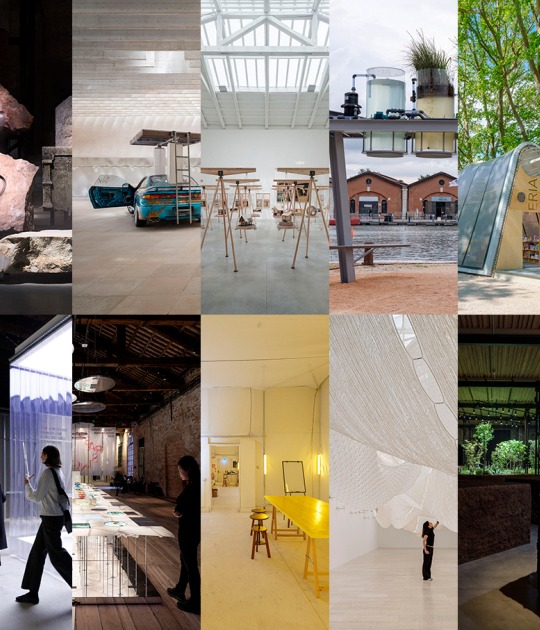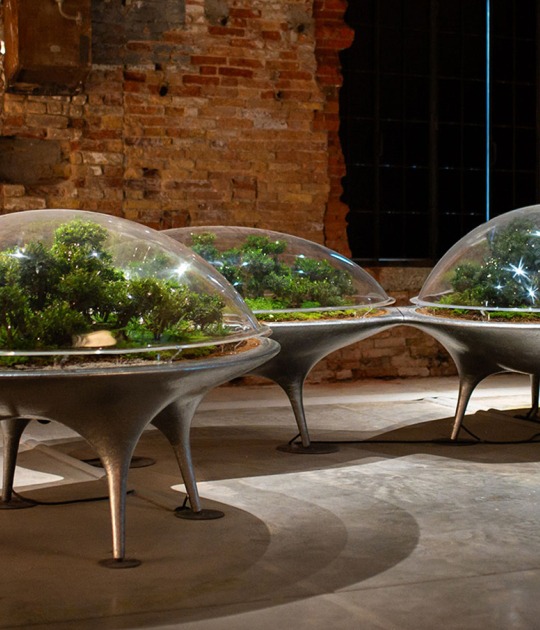'Interior' builds labyrinths and interiors within interiors, breaking down the central space of the Spanish Pavilion. Multiple routes can be taken by the visitors, avoiding the interiors to appear as isolated capsules. The exhibition refers explicitly to the Ulm Pavilion designed by Max Bill for the Baden-Württemberg State Fair in Stuttgart (1956) and its use of the image and the frame. While Max Bill’s Pavilion was based on the repetition of four elements in a spiral, the proposal for the Spanish Pavilion establishes a complex structure in which the images of the twelve projects presented are interrelated between themselves and to a historical context, in a double time warp that generates new categories.
“The curator of the current Venice Architecture Biennale, Rem Koolhaas, has called for reflections on the past, present and future of architecture under the title Fundamentals, an invitation for the national pavilions to investigate the assimilation of modernity over the 100 years since the start of World War I: Absorbing Modernity 1914-2014. On the first centenary of the episode that marked the end of a way of understanding the world - and ultimately its architecture as well - we are now starting to take in the changes to today’s economically and cultural global society, one of the proposed focal points for the Elements of Architecture exhibition in the central pavilion of the Biennale.
In the Spanish Pavilion, curator Iñaki Ábalos focuses the visitor’s gaze on the Interior, particularly on the way a small cluster of environment-related issues (characteristic of the Spanish climate) have been used to configure an architecture exemplified by twelve remarkable works which are radically contemporary but at the same time linked to a solid tradition”.
EXTRACTS FROM “INTERIOR”
“Paradoxically, the architectural interior is in quite good dialectical shape but in a terrible historical state, practically abandoned for an almost ubiquitous technical approach that resolves the project with an envelope of maximized intensity and an extremely banal interior layout.
In this context, the vindication of the Interior could be interpreted as a partial analysis of Spain’s 20th century architectural tradition and an historic tradition that dates back to Roman and Arab architecture. While it is true that during the initial modernity of the 20th century as well as the period following the Spanish Civil War (1936-1939), and indeed until recently, Spanish architecture has produced an admirable variety of interiors, it can also be said that many of these earlier interiors and their wealth of material and spatial solutions were somewhat “forced” by the scarcity of resources available to modern architects in a country devastated by war. Viewed from a distance in time, we can see that these architects were responsible for the inheritance of a renowned, palpable taste for heterodoxy and experimentation in our younger generations. This continuity has contributed to the positive international image now projected by Spanish architecture, with its material, constructional and spatial richness, its refined relationship between public and private space, and its almost unique ability to interpret the past in continuity with the present. More importantly, these features can be regarded as essential qualities for work with a clear purpose and intent in the contemporary global context.
The project implicit to the choice of Interior as the central theme for the Spanish Pavilion at the 14th Venice Architecture Biennale is not so much a vindication of retroactive know-how that looks at itself in the past, as the use of the two formulae proposed by the Biennale’s chief curator Rem Koolhaas, Fundamentals and Absorbing Modernity: 1914-2014, to provoke and steer debate about the validity of the modern experience in the contemporary context. In other words, it is a projective view of the impossibility of fully maintaining the modern agenda, and the way this has facilitated the construction of a heterodox heritage which can, ipso facto, become part of our contemporary culture and be distinguished from the orthodox surrender of the modern to the technocratic mechanics of the interior, vulgarized by commercial products and systems that lead to the disappearance of any possibility of control or design of space. This is not so much a historiographical as a projective, forward-looking review which focuses on the shortcomings of the modern project, drafted from the techno-scientific and cultural perspective of the dual digital and thermodynamic change of course that has had a direct impact on the creative methods and ideas about the role of architecture in contemporary society (…).”
Text by.- Iñaki Ábalos
CREDITS.-
Curator.- Iñaki Ábalos.
Deputy curator.- Enrique Encabo, Inma E. Maluenda y Lluís Ortega.
Promoter.- Gobierno de España. MINISTERIO DE FOMENTO. Secretaría de Estado de Infraestructuras, Transporte y Vivienda. Dirección General de Arquitectura, Vivienda y Suelo.
In collaboration with.- AC/E, ACCIÓN CULTURAL ESPAÑOLA. MINISTERIO DE ASUNTOS EXTERIORES Y DE COOPERACIÓN. Secretaría de Estado de Cooperación Internacional. AECID, Agencia Española de Cooperación Internacional para el Desarrollo. Dirección de Relaciones Culturales y Científicas
With the support of.- FUNDACIÓN CAJA DE ARQUITECTOS.
Dates.- 07 June 2014 - 23 November 2014.
Venue.- Spanish Pavilion. Giardini. Venice, Italy.





















































